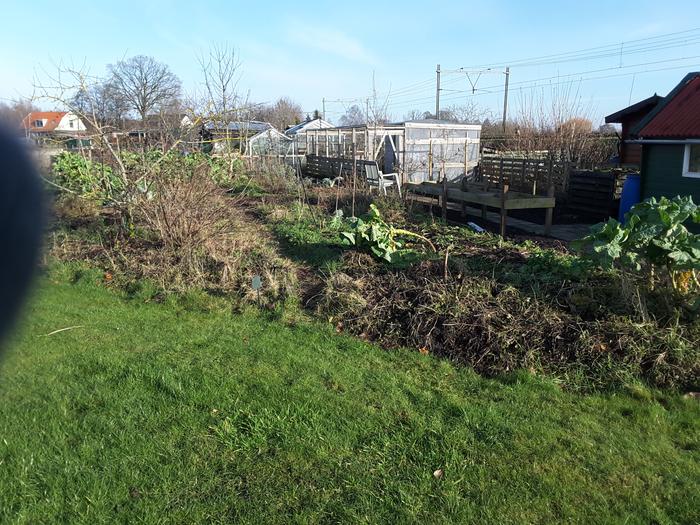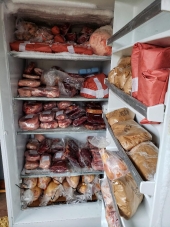posted 4 years ago
This is my first year basically. (previous years I was just casually growing cherry tomatoes + herbs & not composting). I'm in suburban Toronto zone 6.
Pests
Slugs: I didn't notice much in the spring. We did have a dry spring, maybe that's why? But in September and October they were out in full force destroying all my attempts at growing cool weather crops for the fall. Brassicas, Asian greens, mustard greens, spinach, lettuce, rutabagas, turnips, claytonia, maybe even umbellifers got heavily targeted. Seems like they leave corn salad greens alone though, as well as turnip/chard varieties and Malabar spinach. Might try using yeast based slug traps more next year.
Cabbage Worms: Not strictly necessary to use row covers, but if you don't, you have to check on them multiple times per week to keep them in check, maybe even daily when the seedlings are small. Small seedlings can get wiped out very quickly, mature plants will recover, they'll just take a bit longer to reach maturity. Seems cabbage worms don't target mature brassicas as much either, they seem to prefer the more tender seedlings.
Squash Vine Borer: When I first saw that pretty little red moth flying around and didn't know what it was, I thought it was cute. Well it is, but I also wound up with multiple squash vine borer larvae in all my summer squash, resulting in a halting of production in early August, almost 3 months before my first frost. I'll try wrapping their stems in aluminum foil during the vine borer egg laying period (June to early July), and have some back up plants ready to go into the ground in late July/early August.
Cucumber beetles: Sigh... really made growing cucumbers difficult. I got a brief crop in mid-late July but that was pretty much it. I did save seeds from the one plant that survived the onslaught. I'll probably dedicate less space to cucumbers next year though. They caused problems for my cantaloupe too. Might look into bacterial wilt resistant varieties. Cucamelon didn't have any issues with that and tastes fairly similar to cucumbers.
Rabbits and voles: Not sure which did the most damage, but the tops of my umbellifers (except parsnip), my lettuces, salsify, beans, peanut and pea plants all took heavy damage. Brassicas took some damage too. Will need to grow these vulnerable plants in areas protected with hardware cloth next year.
Cut worms: Not too bad, they don't seem to climb raised beds, so just need to be careful that tomatoes, beans, peppers, okra and such planted in non-raised beds have some cut-worm collars for the first couple weeks until their stems get thick enough not to be a target. Having mulch rather than grass between my beds should help too.
Grasshoppers: Not a huge deal but they were targeting my okra and peppers. Didn't kill them or stunt them too much, but I did get some chewing damage.
Aphids: there were a tiny bit on my peppers and eggplant, but after spraying the first bunch off with water, lady bug larvae quickly took care of any that came back.
Japanese beetles: Somewhat of an issue for beans and okra in mid-summer but then they disappeared? Maybe they have a short season or maybe predators moved in?
Flea beetles: They were pretty aggressive on my tomatoes and ground cherries, but the plants were able to withstand the damage and the flea beetles were gone by late summer, so no big deal.
Carrot fly: did some damage to radish roots, but still had a decent amount that were undamaged, so not too bad. Apparently alliums deter them somewhat? I had some chives nearby, but maybe not enough.
My philosophy with pests is that if they only destroy a minority of a particular type of crop, I can tolerate that. If they destroy a majority then I will try one more time and take measures to protect them that next year (ex hardware cloth, companion planting, cutworm collards) but if it's too much work, or the crop still ends up low yielding or tasting the same as at the grocery store, then I'll just grow something else.
Other lessons learned
Tilling/turning the soil way too much. This was when I was just getting started in April/May. Gardening guides recommended it but now I'll just top-dress with compost and otherwise just leave the soil as is.
Don't be worried about weeds as much - roots in the ground are not a bad thing, I just need to make sure they don't overtake my crops and don't go to seed, otherwise no need to fuss.
Not paying enough attention to changing sunlight across seasons. Some locations in my garden that were full sun in summer were basically full shade in fall, as the sun got low enough to be blocked by my house's roof, fences, trees, etc. Even if that doesn't happen, it seems shorter daylight hours and increased cloudiness in fall results in slower growth. Taking these factors into account will mean planting things in different locations as well as planting them earlier if I want to have a fall garden of cool weather crops to harvest in Nov-Dec. On the flipside, some crops will definitely grow faster in mid-summer warmth than in spring, even a lot of brassicas and peas (mid-summer is mostly just 70-90F here though).
Starting more crops indoors. Mostly I kind of improvised this year and started a lot of things late, including some warm weather crops as late as July. I'll try to have all my warm weather crops ready to go in the ground by mid May to early June (depending on their tolerance to 33-50F temperatures), and also start things like chard and brassicas indoors to transplant in mid-April or so.
Plan ways to have food to eat across more of the year. I had a lot in August and September, but not much before then, and not as much as I'd like from October onwards either.
Don't let my tomatoes and beans get too jungle like. I thought by growing them vertically that would provide enough air circulation. But our summers are very humid and those plants all got very big with massive amounts of foliage so by late August powdery mildew, bean rust and other issues were beginning to spread, resulting in significantly reduced yields by late September. So I'll prune my tomatoes more, and avoid sandwiching the pole beans between the fence and tomatoes. Just have either tomatoes or pole beans along the fence and then shorter plants in front.
More perennials: Hoping to try rhubarb, skirret, egyptian walking onion, welsh onion, raspberry, jerusalem artichoke, hablitzia taminoides, hardy figs, strawberries and maybe currant, crosnes, peach, haskap and cinnamon vine (in addition to Saskatoon berry, perennial herbs and sorrel that I already have) next year.
I also want to try new varieties of annuals (new as in I didn't grow them this year). Strawberry blite, salad burnet, roselle, bulbous chervil, mizuna, kale, tomatillo, snake bean, lima beans, leeks, achira, sweet potato, oca, yacon, and maybe mashua.
Successful crops I'll definitely keep growing
Radishes: easy and fast to mature. Plus not that cheap and I like them. You can grow them between other plants, ex between tomatoes and peppers, and by the peppers take up the full 1-2ft you allocated to them, the radishes will have already been harvested.
Summer squash: despite the trouble I had with vine borers, I still got good yields in early summer. I won't bother growing them vertically this time however, especially not the vegetable marrow since those are meant to get very big and need to rest on the ground.
Tomatoes: Cherry tomatoes are really easy to grow and although my harvest got cut short by mildew, I still got 2 good months of fruit from them. Slicing tomatoes work well too, but need a bit more sun it seems. Can't really tell much of a difference between varieties taste wise, I think picking them ripe and growing them in good soil is the main reason they'll taste better than from grocery stores.
Peppers: Produced well from early July to early October, and never got any disease issues. What's not to like? Potted plants can be moved indoors to produce for at least an extra month.
Eggplants: Produced well from late July to late October, also no disease issues and can continue pushing out fruit a bit longer indoors if the plants are in pots. Both peppers and eggplants did better in pots, although that might just be because the pots were in sunnier locations than the in-ground plants.
Okra: Produced well from August to late September. Hoping to maybe extend the season a bit earlier and later by hand pollinating on cool days (seems they don't produce as much pollen in less ideal weather), and trying more cool tolerant and earlier maturing varieties.
Bok Choy: It's cool enough that they don't bolt that much. Honestly I think they bolted more because my soil was tilled rather than heat, because they "unbolted" in August even though August was warmer than July. Some of them also germinated right around the time of our last frost, which I think can cause bolting. Should be careful to plant brassicas after frost risk (probably start them indoors).
Cucamelon: Grows vigourously until frost, matures fast, resistant to disease... Only thing is the fruit can be a bit hard to find under all the foliage if you don't trellis it and allow to just grow as a huge mass on the ground.
Malabar Spinach: Grows well in the summer, and yields well too. No issues with pests/disease.
Ground Cherry: Grows like a weed... So pick a location where they won't smother anything (they kind of smothered my eggplant). Many people recommend waiting for them to fall onto the ground since that's how you know they're ripe. But voles will eat them off the ground real quick, so I recommend picking them off the plant when they're almost ready, and then let them ripen indoors for a few days or longer (they store for weeks at room temp). Give them a few days to ripen indoors and they'll be much sweeter and fruitier tasting than if you eat them off the ground.
Basil: really tasty and easy to grow in large quantities, can grow in part shade. Just need to figure out what disease they got, or else maybe have a 2nd succession ready to plant in mid-summer.
Green beans: so much better than at the store if you pick them small and tender, and you can get great yields in small spaces. You can succession/relay plant bush beans among spring crops for your first harvest of green beans around 2 months after sowing, then pole beans can take over in the later parts of summer and into fall. Just grow the pole beans in a way that'll make them easy to access when you pick them (so arch trellises are probably the best way to grow them).
Peas: soooo much better compared to store bought ones. Rabbits have been giving me a really hard time getting much yield, but I like them enough that I'll try and figure out some way to protect them properly.






 8
8










 3
3





 9
9




 18
18




 7
7




 6
6




 6
6





 4
4




 4
4







 5
5




 3
3




 4
4




 11
11










 4
4




 5
5




 3
3




 4
4




 3
3




 1
1




 4
4








 2
2




 4
4




 5
5




 1
1




 5
5











 8
8




 4
4




 4
4




 2
2




 4
4




 4
4




 2
2










 2
2




 3
3




 3
3




 4
4




 1
1










 1
1




















